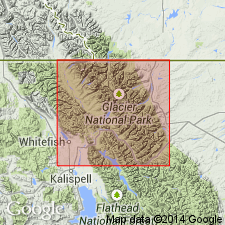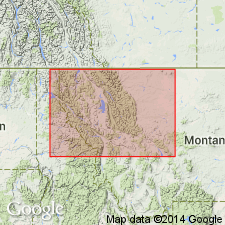
- Usage in publication:
-
- Red Gap member
- Modifications:
-
- First used
- Dominant lithology:
-
- Argillite
- Sandstone
- AAPG geologic province:
-
- Northern Rocky Mountain region
Summary:
First published use as a member of Grinnell formation of Belt series. Intent to name not stated. No type locality designated. Source of geographic name not stated. Is 1,050 to 1,800 ft thick in a generalized section compiled from information on rocks south of Ahern Pass in Lewis Range and in Boulder Pass, Clark Range, Glacier National Park, MT in the Northern Rocky Mountain region, and Waterton Lakes National Park, AT and BC, CN. [Not possible to determine exact areal extent.] Composed of meta-argillite interbedded with lesser amounts of quartzite sandstone and red sandy argillite. Forms Mount Rockwell, Two Medicine Valley. Overlies Rising Wolf member (first used) of Appekunny formation. Underlies Rising Bull member (first used) of Grinnell. Of Algonkian, Proterozoic age.
Source: GNU records (USGS DDS-6; Denver GNULEX).

- Usage in publication:
-
- Red Gap member
- Modifications:
-
- Overview
- AAPG geologic province:
-
- Northern Rocky Mountain region
Summary:
Is the middle member of the Grinnell formation of Ravalli group of Belt series. Type locality [none designated in first publication on Red Gap] stated to be on mountain between Red Gap and Ptarmigan Wall, Glacier National Park, Glacier Co, MT in the Northern Rocky Mountain region. Extends west into Northern Rocky Mountain region and north into Waterton Lakes National Park, AT and BC, CN. Composed of red, brown or green, argillite in thin and thick beds interbedded with pink or white quartzite, brown sandstone and sandy argillite. Maximum thickness 2,800 ft. Argillite, at type, is fine grained, brick to rose red and occurs as thin to thick beds. Rare ripple marks and rain prints; mud cracks abundant. Thins to 700 or 800 ft in Blackiston Valley. Gives description of unit in several regions. Overlies Rising Wolf member of Grinnell. Underlies Rising Bull member of Grinnell. Correlation chart. Of pre-Cambrian age.
Source: GNU records (USGS DDS-6; Denver GNULEX).
For more information, please contact Nancy Stamm, Geologic Names Committee Secretary.
Asterisk (*) indicates published by U.S. Geological Survey authors.
"No current usage" (†) implies that a name has been abandoned or has fallen into disuse. Former usage and, if known, replacement name given in parentheses ( ).
Slash (/) indicates name conflicts with nomenclatural guidelines (CSN, 1933; ACSN, 1961, 1970; NACSN, 1983, 2005, 2021). May be explained within brackets ([ ]).

